A Flexible Operation and Sizing of Battery Energy Storage System Based on Butterfly Optimization Algorithm
Abstract
:1. Introduction
2. Related Work
- (1)
- The proposed strategy in this study evaluates the impact of wind power operation on the DOD and cycle life of the BESS under specifically selected scenarios;
- (2)
- The study investigates the impact of wind power fluctuations in different locations and seasons of the year on the operation of the BESS;
- (3)
- It adopts the method of the capacity incremental strategy to size the BESS until the optimal capacity is reached and the effect of each incremental size is observed on the DOD of the BESS. This strategy shows the flexibility limit allowed within the microgrid distribution generation to achieve an economic operation;
- (4)
- Finally, this paper introduces the use of BOA for solving the optimization problem as a promising approach for the integration of BESS in a wind-penetrated microgrid.
3. Problem Formulation
- Scenario 1: BESS disconnected mode, where the microgrid is operated without the BESS;
- Scenario 2: BESS connected mode, with a constant battery capacity of 100 kWh;
- Scenario 3: BESS connected mode with an optimized battery capacity.
3.1. Wind Power Model
3.2. Generator Model
3.3. Battery Energy Storage Model
4. Proposed Methodology
4.1. The Objective Function
4.2. Constraints
4.2.1. Power Balance Constraint
4.2.2. Generator Constraint
4.2.3. BESS Constraint
4.2.4. Proposed Optimization Procedure
5. Butterfly Optimization Algorithm
5.1. Butterfly
5.2. Fragrance
5.3. Movement of Butterflies
- (a)
- All butterflies can detect the presence of other butterflies due to the emission of some fragrance by all the butterflies;
- (b)
- All butterflies have two patterns of movement: (1) towards the butterfly emitting the best fragrance or (2) moving randomly;
- (c)
- The landscape of the objective function determines the stimulus intensities of the butterflies.
5.4. Generalized BO Algorithm
6. Simulation Results and Discussion
6.1. Scenario 1: BESS Disconnected Mode
6.2. Scenario 2: BESS Connected Mode, with a Constant Battery Capacity of 100 kWh
6.3. Scenario 3: BESS Connected Mode with Optimized Battery Capacity
7. Conclusions
Author Contributions
Funding
Acknowledgments
Conflicts of Interest
Abbreviations
| a | Power exponent |
| Fuel cost coefficients for generation unit i | |
| Emission cost coefficients for generation unit i | |
| Alternating current | |
| Battery energy storage system | |
| Butterfly optimization | |
| Butterfly optimization algorithm | |
| c | Sensory modality of BOA |
| Cost of electricity, USD/MWh | |
| Cost function of battery energy storage system | |
| Total operating cost of diesel generation units, USD/MWh | |
| Battery cost at time t, USD | |
| Initial battery capacity cost, USD | |
| Generator cost at time t, USD | |
| Wind cost at time t, USD | |
| Daily cost of wind power dissipation, USD/MWh | |
| Cost of power exchanged, USD/MWh | |
| Cayote optimization algorithm | |
| Capital recovery cost, USD | |
| Power generated by diesel generation unit i, MW | |
| Depth of discharge of energy storage system, MWh | |
| Depth of discharge of battery energy storage system at time t, MWh | |
| Battery energy | |
| Maximum rated energy of battery, MWh | |
| Minimum rated energy of battery, MWh | |
| Energy storage system | |
| Battery storage capacity | |
| Battery efficiency, USD/MWh | |
| Charging efficiency of battery at time t | |
| Discharging efficiency of battery at time t | |
| Fragrance of the butterfly | |
| Fuel cost, USD/MWh | |
| Firefly optimization | |
| Genetic algorithm | |
| Grey-wolf optimization | |
| I | Stimulus intensity |
| Initial wind plant cost, USD | |
| Interest rate | |
| Projected battery lifetime, in years | |
| J | Objective function |
| Lead ion | |
| Microgrid | |
| Number of cycles of energy storage at a particular DOD | |
| Nickel–cadmium | |
| Charging power of the battery at time t | |
| Discharging power of the battery at time t | |
| Battery power, MW | |
| Battery energy, MWh | |
| Load power demand, MW | |
| Grid power, MW | |
| Output power of the generation unit im MW | |
| Demanded or load power at time t, MW | |
| Wind power output, MW | |
| Wind power output at time t, MW | |
| Battery power at time t, MW | |
| Maximum rated power of battery, MW | |
| Minimum rated power of battery, MW | |
| Maximum capacity of the transmission line, MVA | |
| Particle swarm optimization | |
| Photo-voltaic | |
| r | A random number |
| Renewable energy | |
| Renewable energy sources | |
| State of charge | |
| State of charge of battery at time t | |
| T | Period |
| t | Iteration number |
| Uninterrupted power supply | |
| Wind cut-in speed, km/h | |
| Rated wind speed, km/h | |
| Wind speed at time t, km/h | |
| Whale optimization algorithm | |
| solution vector for the butterfly at iteration t |
References
- Tiamiyu, R.A.; Salman, U.T. Deficit in Leadership Qualities Negating Efforts in Curtailing Climate Change. Environ. Ecol. Res. 2021, 9, 215–223. [Google Scholar] [CrossRef]
- Gao, D.W. Energy Storage for Sustainable Microgrid; Academic Press: Cambridge, MA, USA, 2015. [Google Scholar]
- Bahramirad, S.; Daneshi, H. Optimal sizing of smart grid storage management system in a microgrid. In Proceedings of the 2012 IEEE PES Innovative Smart Grid Technologies (ISGT), Washington, DC, USA, 16–20 January 2012; pp. 1–7. [Google Scholar] [CrossRef]
- Salman, U.; Khan, K.; Alismail, F.; Khalid, M. Techno-Economic Assessment and Operational Planning of Wind-Battery Distributed Renewable Generation System. Sustainability 2021, 13, 6776. [Google Scholar] [CrossRef]
- Simeon, M.; Adoghe, A.U.; Wara, S.T.; Oloweni, J.O. Renewable Energy Integration Enhancement Using Energy Storage Technologies. In Proceedings of the 2018 IEEE PES/IAS PowerAfrica, Cape Town, South Africa, 28–29 June 2018; pp. 864–868. [Google Scholar] [CrossRef]
- Malkowski, R.; Bucko, P.; Jaskólski, M.; Pawlicki, W.; Stoltmann, A. Simulation of the Dynamics of Renewable Energy Sources with Energy Storage Systems. In Proceedings of the 2018 15th International Conference on the European Energy Market (EEM), Lodz, Poland, 27–29 June 2018; pp. 1–5. [Google Scholar] [CrossRef]
- Liu, X.; Su, B. Microgrids—An integration of renewable energy technologies. In Proceedings of the 2008 China International Conference on Electricity Distribution, Guangzhou, China, 10–13 December 2008. [Google Scholar]
- Ahmed, A.; Jiang, T. Operation Management of Power Grid System with Renewable Energy Sources and Energy Storage System Integrations. In Proceedings of the 2018 2nd IEEE Conference on Energy Internet and Energy System Integration (EI2), Beijing, China, 20–22 October 2018; pp. 1–6. [Google Scholar] [CrossRef]
- Viral, R.; Khatod, D. Optimal planning of distributed generation systems in distribution system: A review. Renew. Sustain. Energy Rev. 2012, 16, 5146–5165. [Google Scholar] [CrossRef]
- Parhizi, S.; Lotfi, H.; Khodaei, A.; Bahramirad, S. State of the art in research on microgrids: A review. IEEE Access 2015, 3, 890–925. [Google Scholar] [CrossRef]
- Ghiassi-Farrokhfal, Y.; Rosenberg, C.; Keshav, S.; Adjaho, M. Joint Optimal Design and Operation of Hybrid Energy Storage Systems. IEEE J. Sel. Areas Commun. 2016, 34, 639–650. [Google Scholar] [CrossRef] [Green Version]
- Pandžić, H.; Bobanac, V. An accurate charging model of battery energy storage. IEEE Trans. Power Syst. 2019, 34, 1416–1426. [Google Scholar] [CrossRef]
- Bradbury, K.; Pratson, L.; Patiño-Echeverri, D. Economic viability of energy storage systems based on price arbitrage potential in real-time US electricity markets. Appl. Energy 2014, 114, 512–519. [Google Scholar] [CrossRef]
- Akhil, A.A.; Huff, G.; Currier, A.B.; Kaun, B.C.; Rastler, D.M.; Chen, S.B.; Cotter, A.L.; Bradshaw, D.T.; Gauntlett, W.D. Electricity Storage Handbook in Collaboration with NRECA; Sandia National Laboratories: Albuquerque, NM, USA, 2013.
- San Martín, J.I.; Zamora, I.; San Martín, J.J.; Aperribay, V.; Eguia, P. Energy Storage Technologies for Electric Applications. Kernel Description. Available online: http://www.sc.ehu.es/sbweb/energias-renovables/temas/almacenamiento/almacenamiento.html (accessed on 4 January 2020).
- Fathima, A.H.; Palanisamy, K. Battery energy storage applications in wind integrated systems—A review. In Proceedings of the 2014 International Conference on Smart Electric Grid (ISEG), Guntur, India, 19–20 September 2014; pp. 1–8. [Google Scholar] [CrossRef]
- Sebastián, R.; Peña-Alzola, R. Study and simulation of a battery based energy storage system for wind diesel hybrid systems. In Proceedings of the 2012 IEEE International Energy Conference and Exhibition (ENERGYCON), Florence, Italy, 9–12 September 2012; pp. 563–568. [Google Scholar] [CrossRef]
- Fossati, J.P.; Galarza, A.; Martín-Villate, A.; Fontan, L. A method for optimal sizing energy storage systems for microgrids. Renew. Energy 2015, 77, 539–549. [Google Scholar] [CrossRef]
- Sharma, S.; Bhattacharjee, S.; Bhattacharya, A. Grey wolf optimisation for optimal sizing of battery energy storage device to minimise operation cost of microgrid. IET Gener. Transm. Distrib. 2016, 10, 625–637. [Google Scholar] [CrossRef]
- Yuan, Z.; Wang, W.; Wang, H.; Yildizbasi, A. A new methodology for optimal location and sizing of battery energy storage system in distribution networks for loss reduction. J. Energy Storage 2020, 29, 101368. [Google Scholar] [CrossRef]
- Zolfaghari, M.; Ghaffarzadeh, N.; Ardakani, A.J. Optimal sizing of battery energy storage systems in off-grid micro grids using convex optimization. J. Energy Storage 2019, 23, 44–56. [Google Scholar] [CrossRef]
- Wong, L.A.; Ramachandaramurthy, V.K.; Walker, S.L.; Taylor, P.; Sanjari, M.J. Optimal placement and sizing of battery energy storage system for losses reduction using whale optimization algorithm. J. Energy Storage 2019, 26, 100892. [Google Scholar] [CrossRef]
- Zhang, Y.; Su, Y.; Wang, Z.; Liu, F.; Li, C. Cycle-Life-Aware Optimal Sizing of Grid-Side Battery Energy Storage. IEEE Access 2021, 9, 20179–20190. [Google Scholar] [CrossRef]
- Eroshenko, S.A.; Samoylenko, V.O.; Pazderin, A.V. Renewable energy sources for perspective industrial clusters development. In Proceedings of the 2016 2nd International Conference on Industrial Engineering, Applications and Manufacturing (ICIEAM), Chelyabinsk, Russia, 19–20 May 2016; pp. 1–5. [Google Scholar] [CrossRef]
- Rafique, M.; Rehman, S.; Alam, M.; Alhems, L. Feasibility of a 100 MW Installed Capacity Wind Farm for Different Climatic Conditions. Energies 2018, 11, 2147. [Google Scholar] [CrossRef] [Green Version]
- Yang, Z.; Xia, L.; Guan, X. Fluctuation Reduction of Wind Power and Sizing of Battery Energy Storage Systems in Microgrids. IEEE Trans. Autom. Sci. Eng. 2020, 17, 1195–1207. [Google Scholar] [CrossRef]
- Salman, U.T.; Al-Ismail, F.S.; Khalid, M. Optimal Sizing of Battery Energy Storage for Grid-Connected and Isolated Wind-Penetrated Microgrid. IEEE Access 2020, 8, 91129–91138. [Google Scholar] [CrossRef]
- Sufyan, M.; Rahim, N.A.; Tan, C.K.; Muhammad, M.A.; Raihan, S.R.S. Optimal sizing and energy scheduling of isolated microgrid considering the battery lifetime degradation. PLoS ONE 2019, 14, e0211642. [Google Scholar] [CrossRef]
- Abdulgalil, M.A.; Khalid, M.; Alismail, F. Optimal sizing of battery energy storage for a grid-connected microgrid subjected to wind uncertainties. Energies 2019, 12, 2412. [Google Scholar] [CrossRef] [Green Version]
- Rehman, S.; Umar, T.; Salman, L.M.A. Wind Farm-Battery Energy Storage Assessment in Grid-Connected Microgrids. Energy Eng. 2020, 117, 343–365. [Google Scholar] [CrossRef]
- Krishan, O.; Suhag, S. A novel control strategy for a hybrid energy storage system in a grid-independent hybrid renewable energy system. Int. Trans. Electr. Energy Syst. 2020, 30, e12262. [Google Scholar] [CrossRef]
- Salman, U.T.; Abdulgalil, M.A.; Wasiu, O.S.; Khalid, M. Energy Management Strategy Considering Battery Efficiency for Grid-Tied Microgrids During Summer in the Kingdom of Saudi Arabia. In Proceedings of the 2019 8th International Conference on Renewable Energy Research and Applications (ICRERA), Brasov, Romania, 3–6 November 2019; pp. 422–427. [Google Scholar]
- Zhou, C.; Qian, K.; Allan, M.; Zhou, W. Modeling of the cost of EV battery wear due to V2G application in power systems. IEEE Trans. Energy Convers. 2011, 26, 1041–1050. [Google Scholar] [CrossRef]
- Khorramdel, H.; Aghaei, J.; Khorramdel, B.; Siano, P. Optimal Battery Sizing in Microgrids Using Probabilistic Unit Commitment. IEEE Trans. Ind. Inform. 2016, 12, 834–843. [Google Scholar] [CrossRef]
- Arora, S.; Singh, S. Butterfly optimization algorithm: A Novel Approach for Global Optimization. Soft Comput. 2019, 23, 715–734. [Google Scholar] [CrossRef]
- Alahmed, A.; Taiwo, S.; Abido, M. Implementation and Evaluation of Grey Wolf optimization Algorithm on Power System Stability Enhancement. In Proceedings of the 2019 IEEE 10th GCC Conference & Exhibition (GCC), Kuwait, Kuwait, 9–23 April 2019; pp. 1–6. [Google Scholar]
- Abdul-Rashid, R.; Alawode, B.O. Robustness Evaluation of the Butterfly Optimization Algorithm on a Control System. arXiv 2019, arXiv:1912.00185. [Google Scholar]
- Tubishat, M.; Alswaitti, M.; Mirjalili, S.; Al-Garadi, M.A.; Alrashdan, M.T.; Rana, T.A. Dynamic Butterfly Optimization Algorithm for Feature Selection. IEEE Access 2020, 8, 194303–194314. [Google Scholar] [CrossRef]
- Abdulhussein, K.G.; Yasin, N.M.; Hasan, I.J. Comparison between butterfly optimization algorithm and particle swarm optimization for tuning cascade PID control system of PMDC motor. Int. J. Power Electron. Drive Syst. 2021, 12, 736–744. [Google Scholar] [CrossRef]
- Yang, D.; Wang, X.; Tian, X.; Zhang, Y. Improving monarch butterfly optimization through simulated annealing strategy. J. Ambient. Intell. Humaniz. Comput. 2020, 1–12. Available online: https://www.researchgate.net/profile/Ihsan-Hasan-2/publication/352368105_Comparison_between_butterfly_optimization_algorithm_and_particle_swarm_optimization_for_tuning_cascade_PID_control_system_of_PMDC_motor/links/60c6918292851ca6f8e9b577/Comparison-between-butterfly-optimization-algorithm-and-particle-swarm-optimization-for-tuning-cascade-PID-control-system-of-PMDC-motor.pdf (accessed on 16 November 2021). [CrossRef] [Green Version]
- Parambil, R.K. Economic Load Dispatch Problem Using Butterfly Optimization Algorithm. Eur. J. Mol. Clin. Med. 2020, 7, 2773–2778. [Google Scholar]
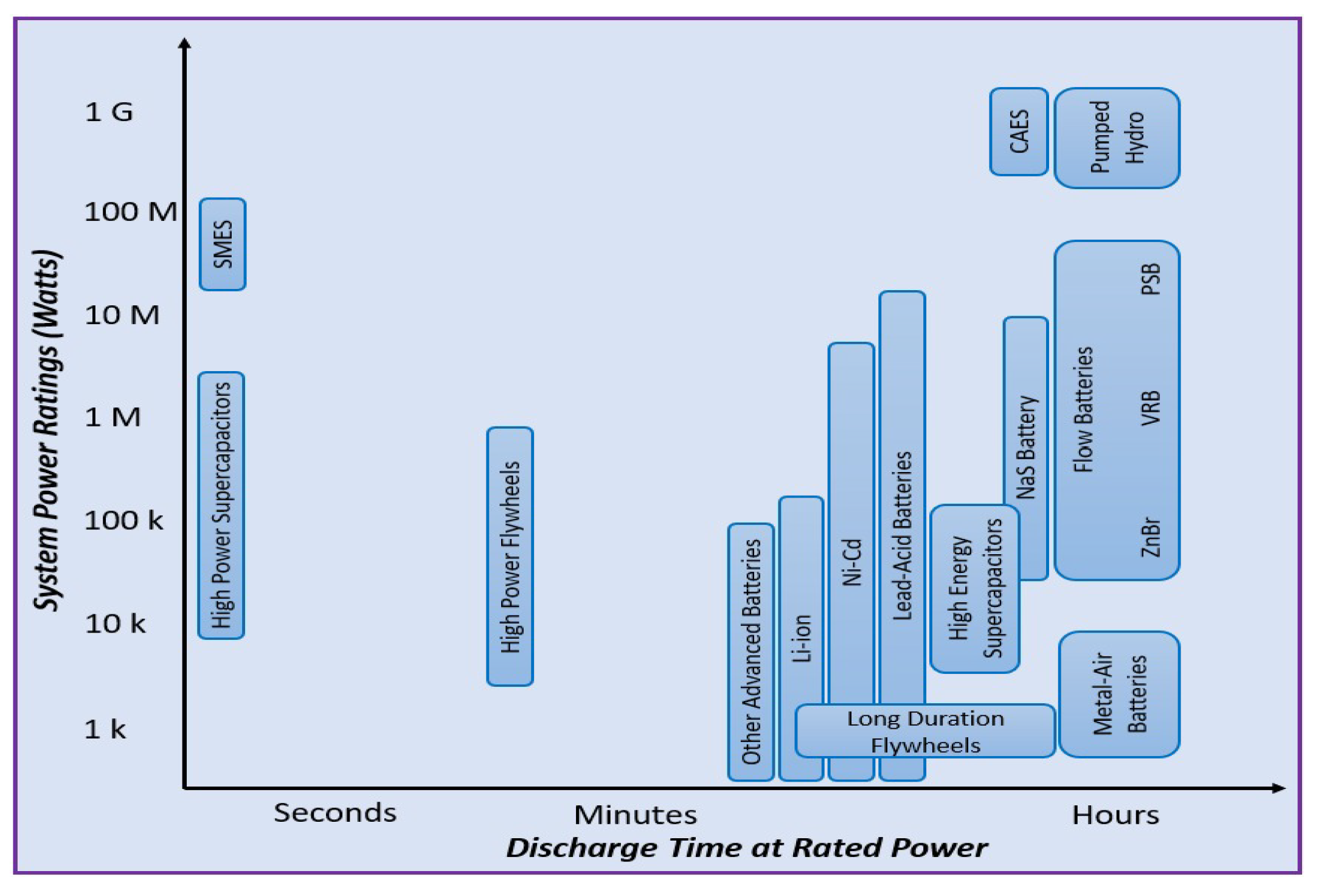
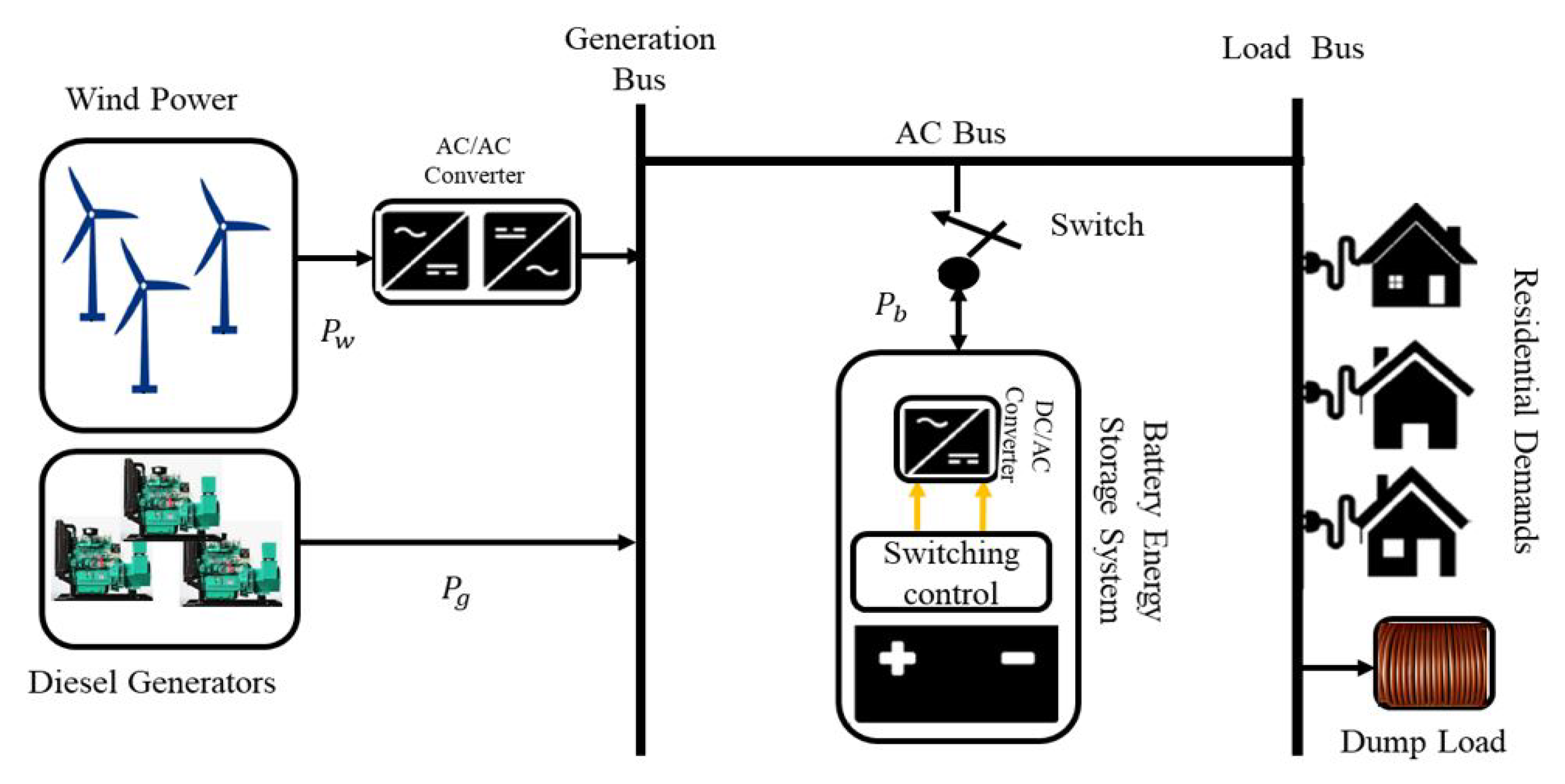
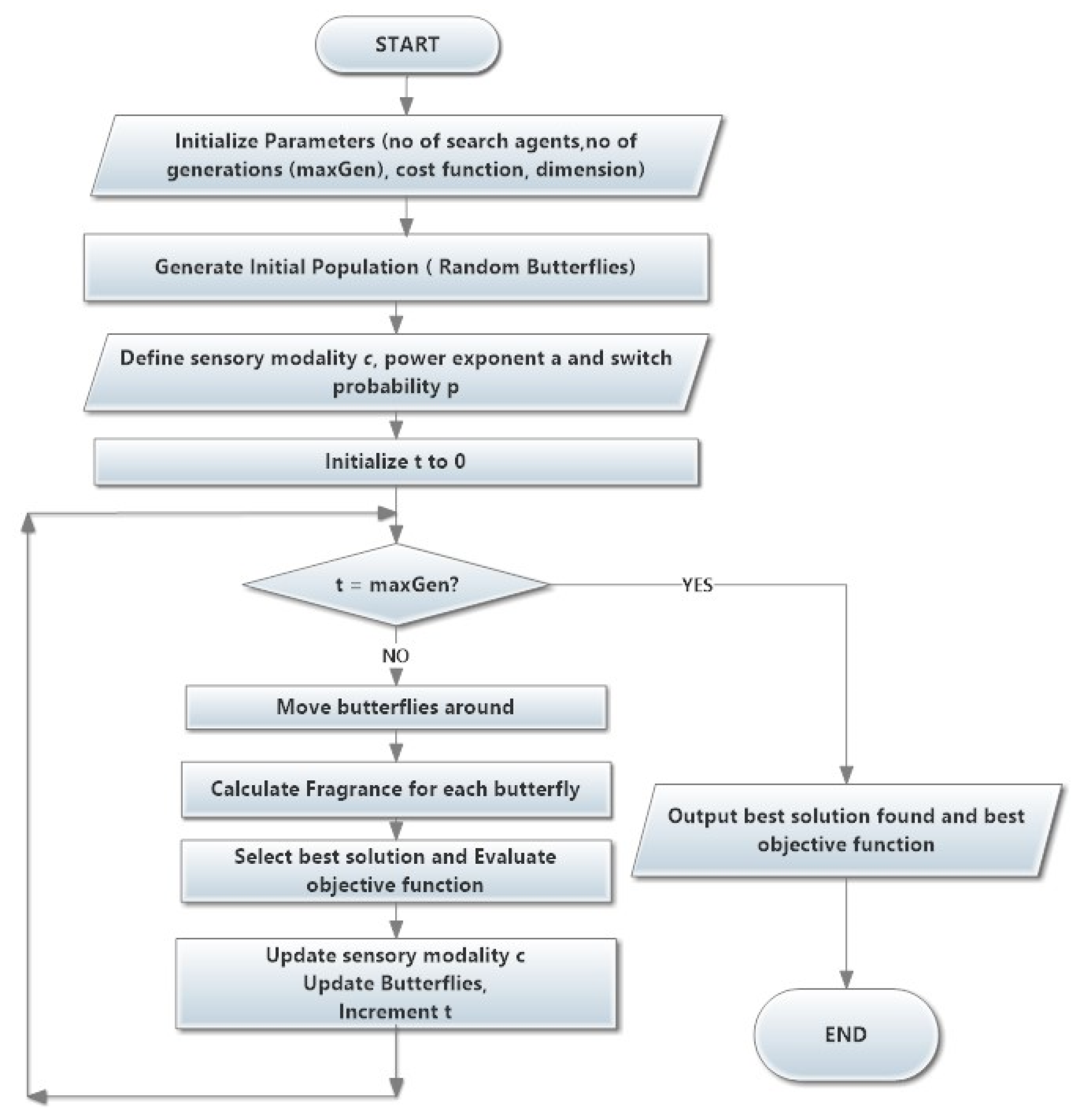
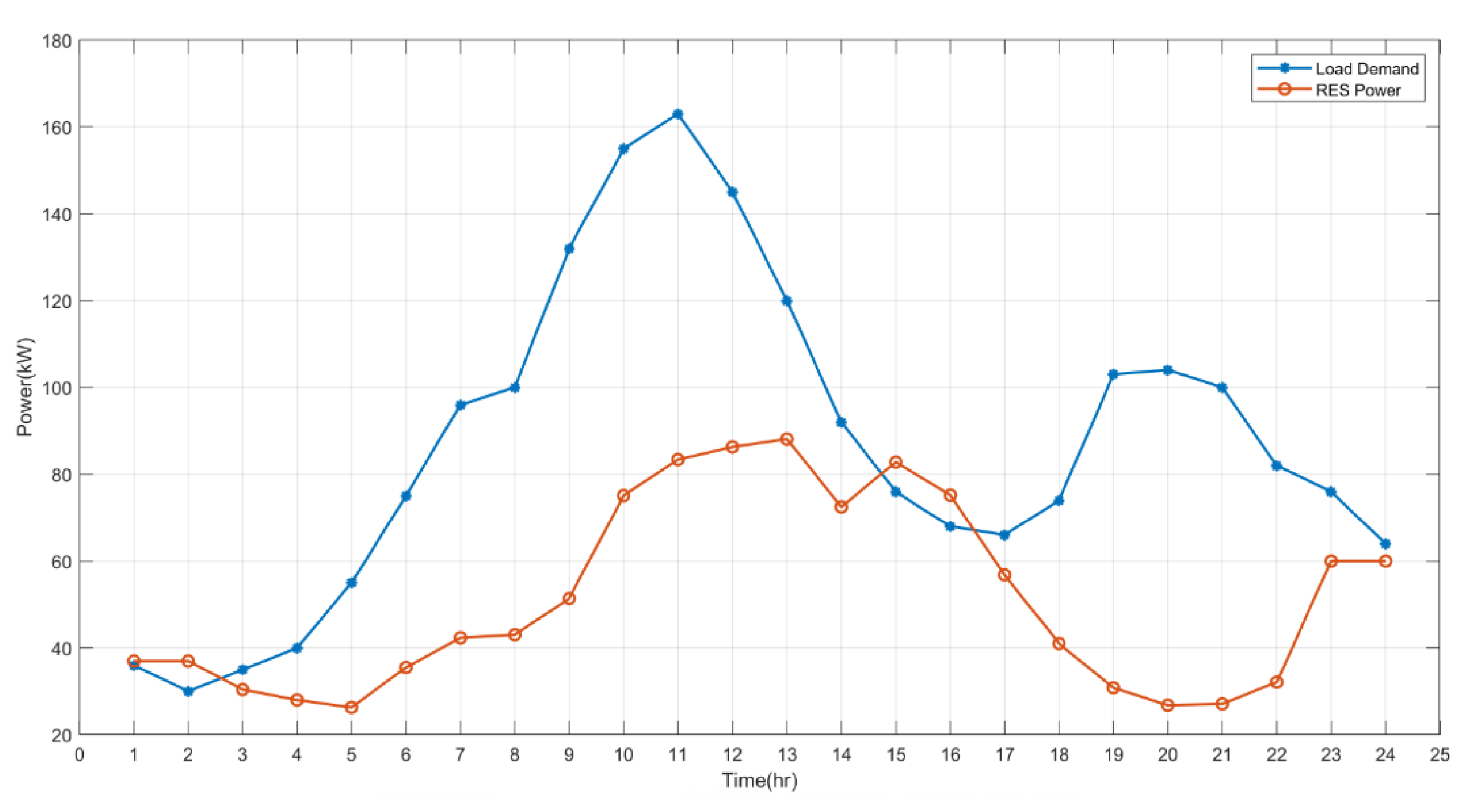
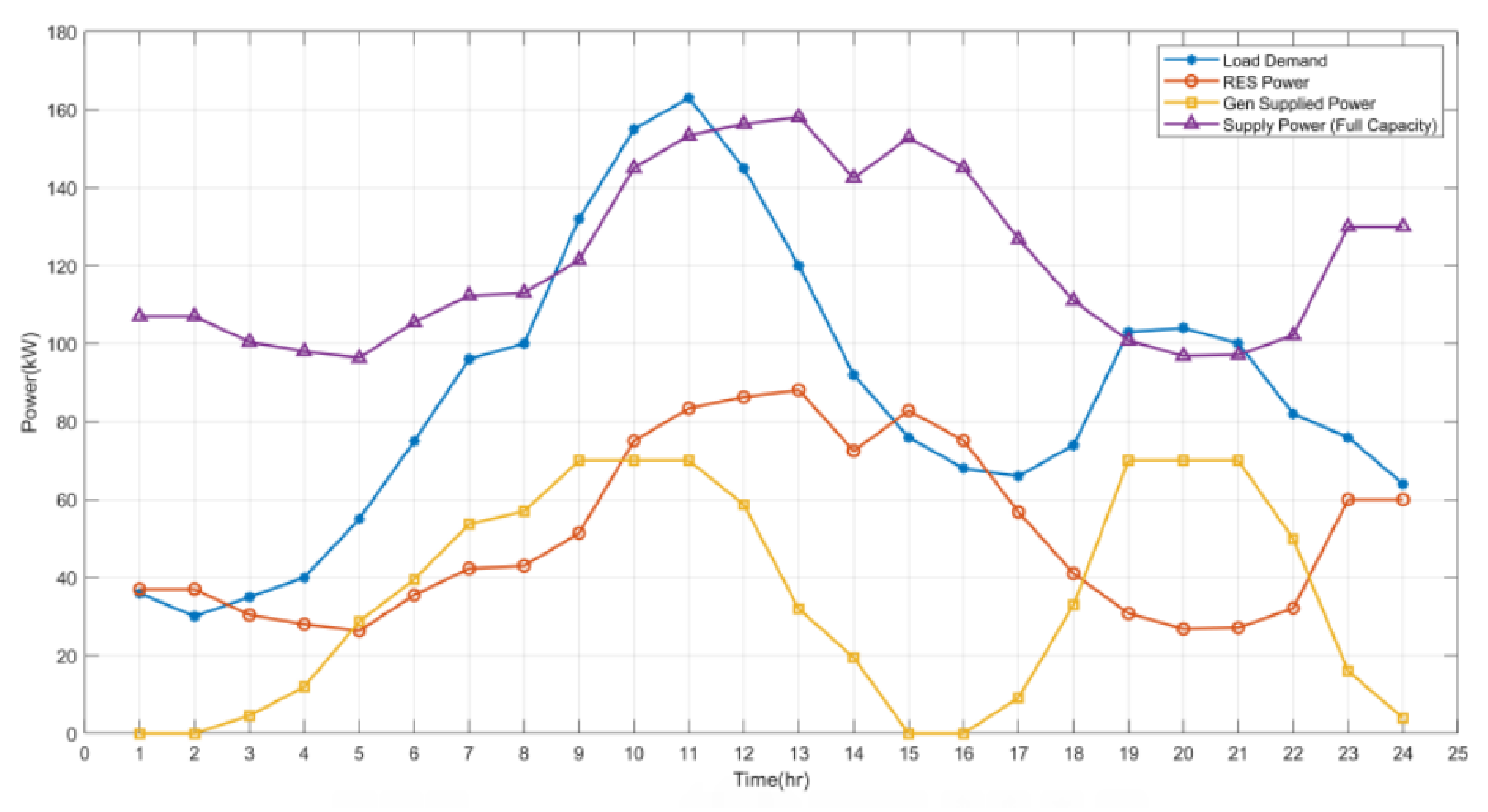
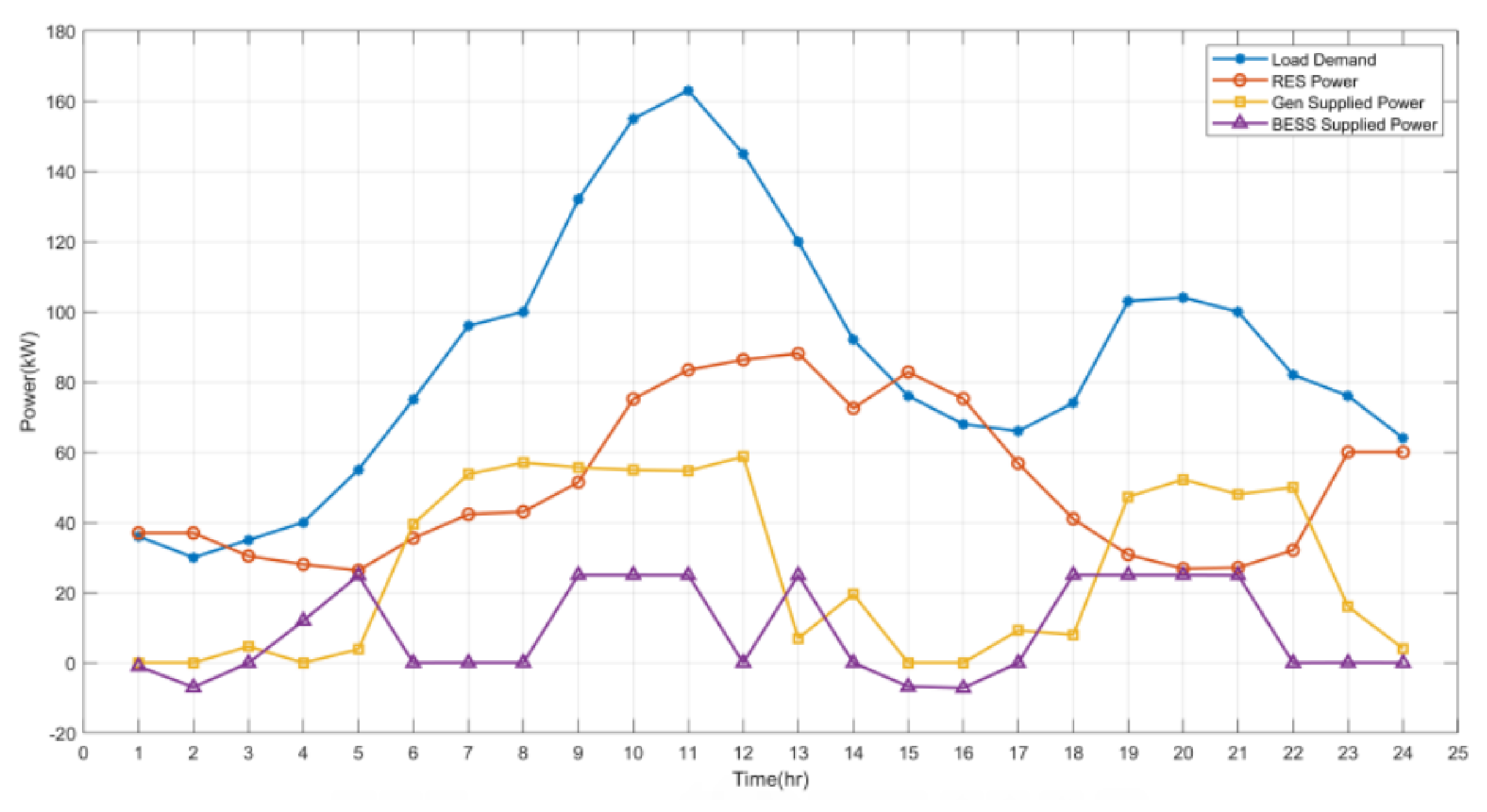

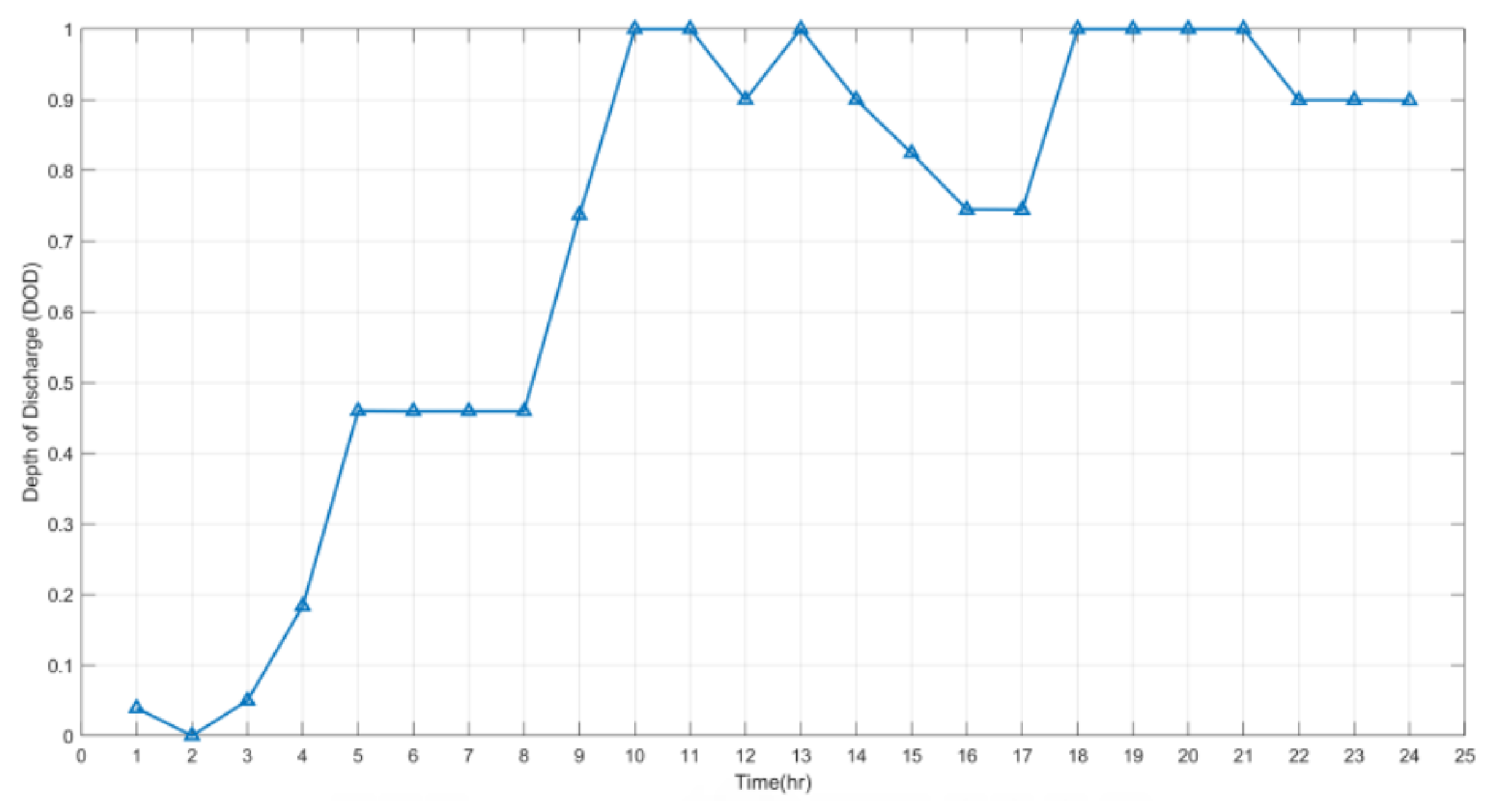
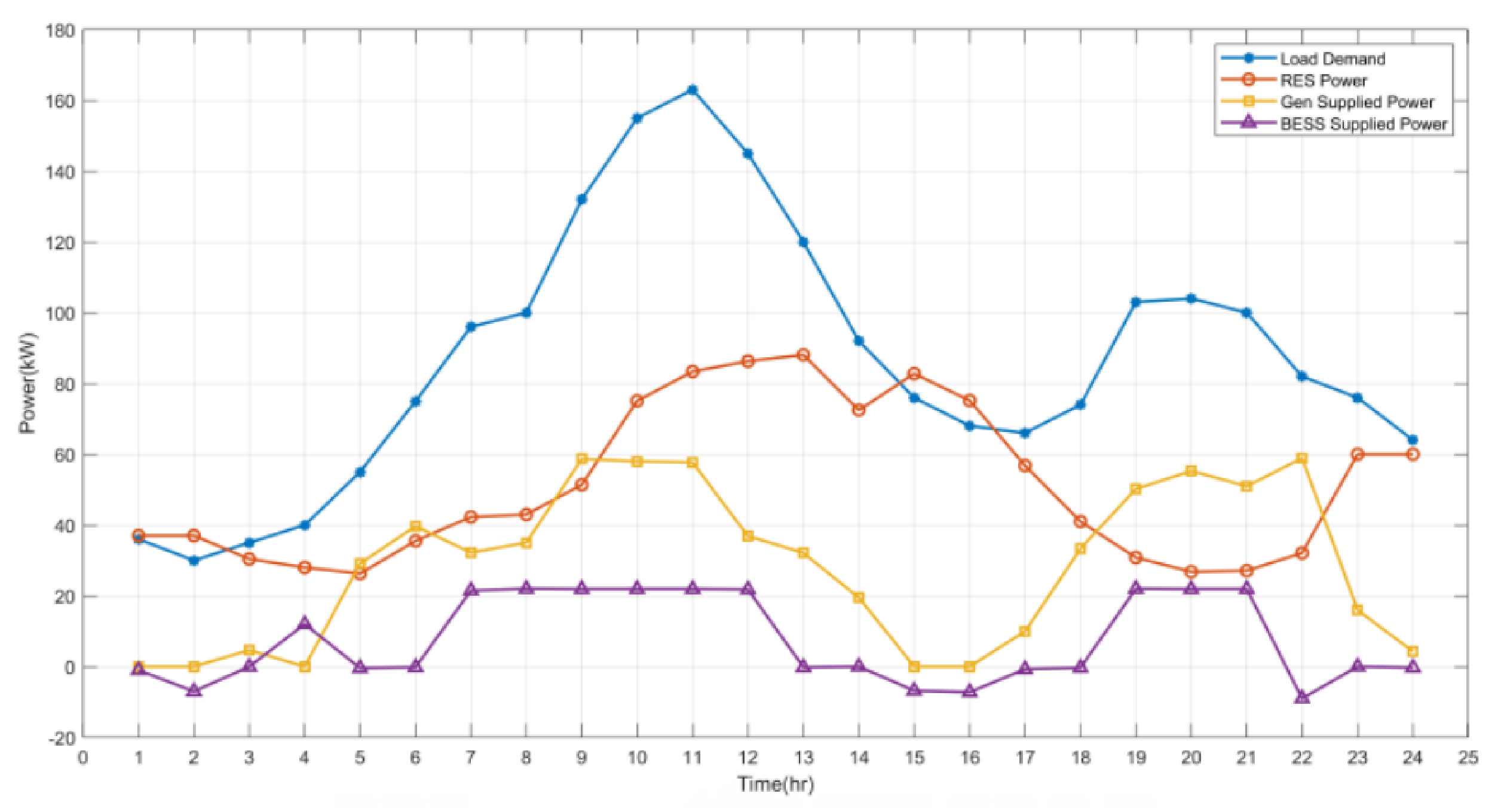
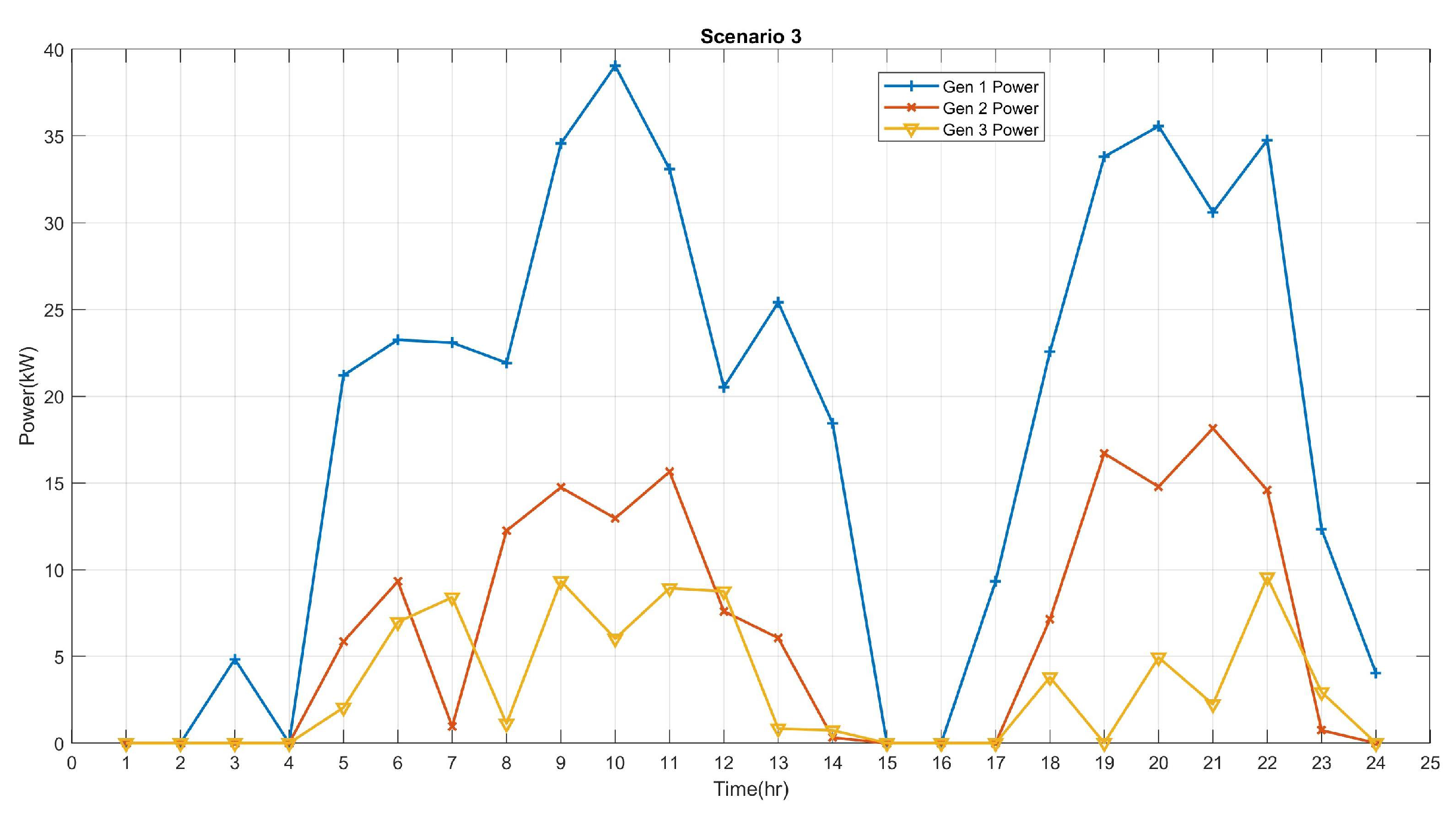
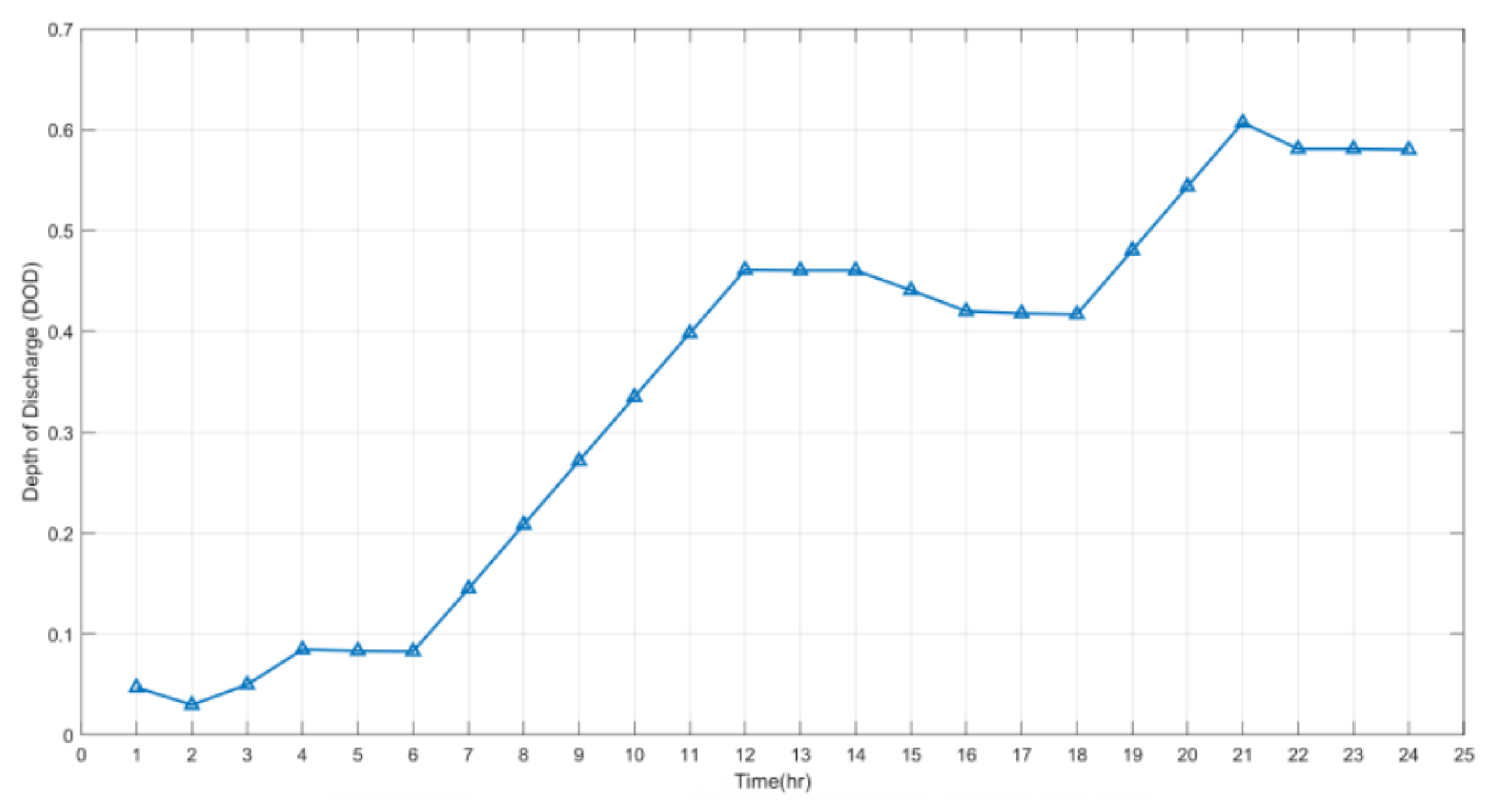
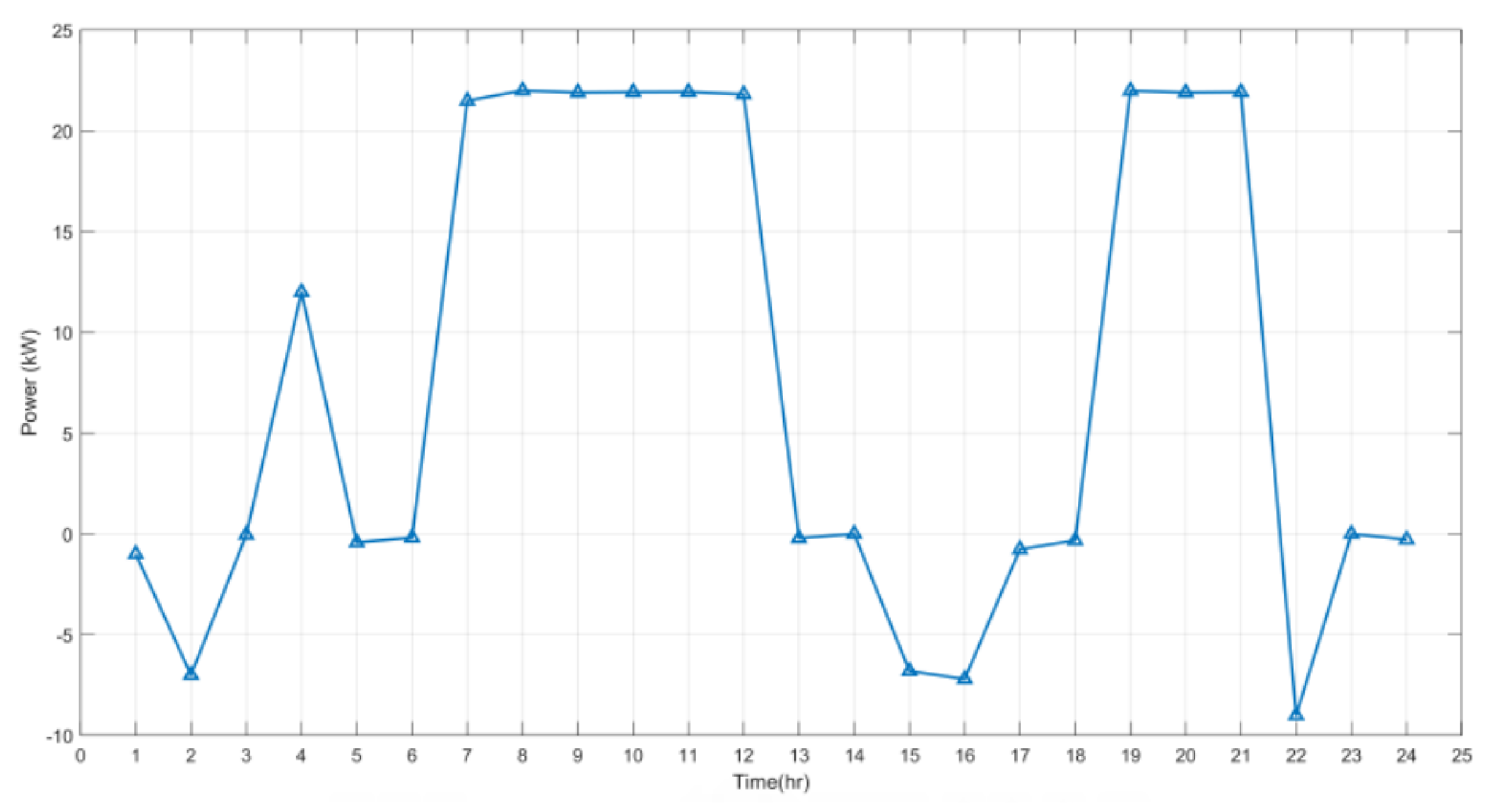
| Diesel 1 | Diesel 2 | Diesel 3 | |
|---|---|---|---|
| ($/kW2) | 0.0001 | 0.0001 | 0.0001 |
| ($/kW) | 0.0438 | 0.0479 | 0.0490 |
| ($) | 0.3 | 0.5 | 0.4 |
| (kW) | 0.0 | 0.0 | 0.0 |
| (kW) | 40.0 | 20.0 | 10.0 |
| Parameter | Value |
|---|---|
| Initial SOC (%) | 80 |
| (%) | 90 |
| (%) | 10 |
| Initial Capital Cost ($/kWh) | 625 |
| Maintenance Cost ($/kWh)/year | 25 |
| Round-trip Efficiency (%) | 90 |
| Lifetime (years) | 3 |
| (kW) | 10 |
| (kW) | 25 |
| Interest Rate (%) | 6 |
Publisher’s Note: MDPI stays neutral with regard to jurisdictional claims in published maps and institutional affiliations. |
© 2021 by the authors. Licensee MDPI, Basel, Switzerland. This article is an open access article distributed under the terms and conditions of the Creative Commons Attribution (CC BY) license (https://creativecommons.org/licenses/by/4.0/).
Share and Cite
Alawode, B.O.; Salman, U.T.; Khalid, M. A Flexible Operation and Sizing of Battery Energy Storage System Based on Butterfly Optimization Algorithm. Electronics 2022, 11, 109. https://doi.org/10.3390/electronics11010109
Alawode BO, Salman UT, Khalid M. A Flexible Operation and Sizing of Battery Energy Storage System Based on Butterfly Optimization Algorithm. Electronics. 2022; 11(1):109. https://doi.org/10.3390/electronics11010109
Chicago/Turabian StyleAlawode, Basit Olakunle, Umar Taiwo Salman, and Muhammad Khalid. 2022. "A Flexible Operation and Sizing of Battery Energy Storage System Based on Butterfly Optimization Algorithm" Electronics 11, no. 1: 109. https://doi.org/10.3390/electronics11010109
APA StyleAlawode, B. O., Salman, U. T., & Khalid, M. (2022). A Flexible Operation and Sizing of Battery Energy Storage System Based on Butterfly Optimization Algorithm. Electronics, 11(1), 109. https://doi.org/10.3390/electronics11010109







